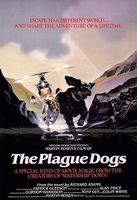
The Plague Dogs – Revival of a Masterpiece*
By Loredana Loy
Based on the book with the same title by Richard Adams, The Plague Dogs (1982) is a one of a kind movie. Snitter and Rowf are two dogs who escape from an animal experimentation facility only to find that the outside world is just as cruel. They try to survive in the wild with the help of a fox. After the facility spreads a rumor that the dogs are carrying the plague in order to speed their capture, the media generate a commotion around their escape. Hunted by the military and the farmers on whose sheep the dogs feed upon in order to survive, chased and feared by people due to the potential infection anxiety, the dogs’ journey is a harrowing one.
Created as an animation film because director Martin Rosen thought it was the only way to tell this story, at least at the time, The Plague Dogs has the feel of a live-action movie. It is exceptional in its unapologetic stance of siding with the animals and breaking away from the ubiquitous anthropocentric[i] tropes. Furthermore, the movie does not attempt to cater to mainstream audiences, being more concerned with telling an honest and realistic story rather than an entertaining one.
The film was called a masterpiece and “state of the art” by the critics and has excellent credentials represented by the team of writers, producers, and actors providing the voices (John Hurt and Patrick Stewart among others). Thirty years after it opened, the film still ignites discussion, being regarded as one of the few movies with a clear and uncompromising animal advocacy message that ever entered public discourse. As a side note, the film opened at the Film Forum in New York in 1985 and it was reviewed by The New York Times.
The Plague Dogs is told from the perspective of the animals. There is very little human presence. In fact the only contact between the animals and the humans on screen always end in disaster. The film also touches on the so-called “dirty trade” of selling animals from shelters and pounds to biomedical research.[ii]Snitter is born in the facility, but Rowf ends up as an experimentation subject after his guardian passes away.
What is also unique about The Plague Dogs, and what makes it stand apart from other popular animation movies, is that the dogs are not anthropomorphized.[iii] Although the dogs can communicate and reason, they remain dogs and their anxieties remain “dog-focused,” such as struggling to survive and not succumb to hunger and cold. In addition, when humans are on screen the dogs never speak. Being able to speak does not make the dogs human as an article in Screen International notes: “being given words to say does not change Snitter and Rowf into people. Everything that happens to them happens because they are dogs” (Bilbow, 1982).
This way of portraying the animals invites the viewer to imagine the world through the perspective of the other in a genuine manner. An article in Moria magazine says that the dogs’ portrayal allows us “to interpret the world through the eyes of the animals” (Scheib, 2012). For example, because his view of the world is determined by his sole life experience, that of being tortured by humans, when he sees snow for the first time, Rowf says: “Ooohhh they’re clever, they really made it too cold for us to live.”
In addition, The Plague Dogs distinguishes itself from other movies that address animal experimentation, and which usually convey a convoluted message about this issue in their narratives, by portraying animal experimentation in a realistic manner. In fact, the experiments portrayed in the movie are inspired by real experiments. The opening scene shows Snitter drowning in an endurance experiment through which he is put through over and over, being revived once he drowns. A review in The Minneapolis Star Tribune calls the movie “a spirited condemnation of experimental animal abuse” and a “realistic portrayal of the tortures inflicted in the name of science” (Stricker, 1986).
The film is imbued with misanthropic tones; however, while other similar movies allowed their human characters to have some redemptive qualities, The Plague Dogs is less benevolent to do so. While most animation stories offer escapist uplifting dreams and visions of a better world for animals, The Plague Dogs stays anchored in the gloomy reality. Most importantly, The Plague Dogs does not stand in for some metaphorical human story—this story could not be the story of humans. An article in The Guardian says it best: “Plague Dogs isn’t an allegory like Animal Farm. It really is about animals” (French, 1982).
The film seems to be experiencing a revival through its cult following these days. This article hopes to augment this movement. A movie such as this one should not fade into obscurity.
The Plague Dogs is streaming on Amazon and is available on Netflix.*This article first appeared on Reel Change reelchange.net
[i]Anthropocentrism is the cultural ideology that assigns humans the utmost importance in society.
[ii]The sale of unwanted companion animals to biomedical research labs is well-documented (see Vetri, 1986, Animal Research and Shelter Animals: An Historical Analysis of the Pound Animal Controversy).
[iii] Anthropomorphism is the attribution of human characteristics to animals.
References
Bilbow, M. (1982, November 6). The Plague Dogs. Screen International, pp. 18.
French, P. (1982, October 24). The Hampstead dogs. The Observer, pp. 31.
Scheib, R. (2013, January 1). The Plague Dogs. Moria. Retrieved from:https://moria.Co.nz/fantasy/plague-Dogs-1982.Htm
Strickler, J. (1985, January 3). Plagued Dogs is for animal lovers but not for children. Minneapolis Star Tribune, pp. 4C.